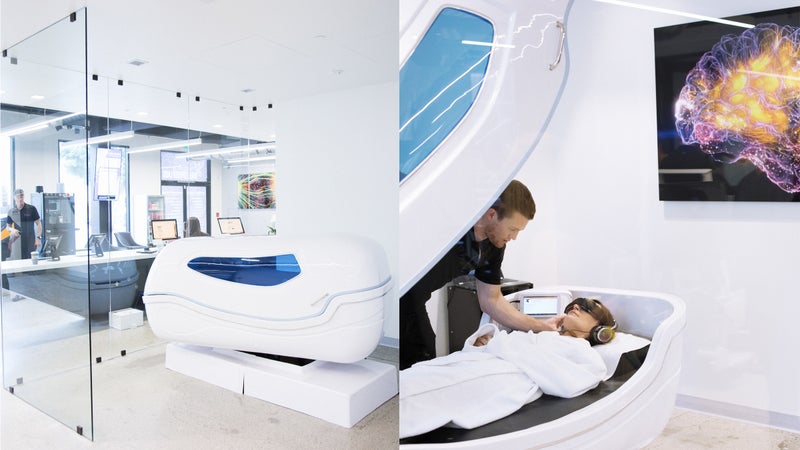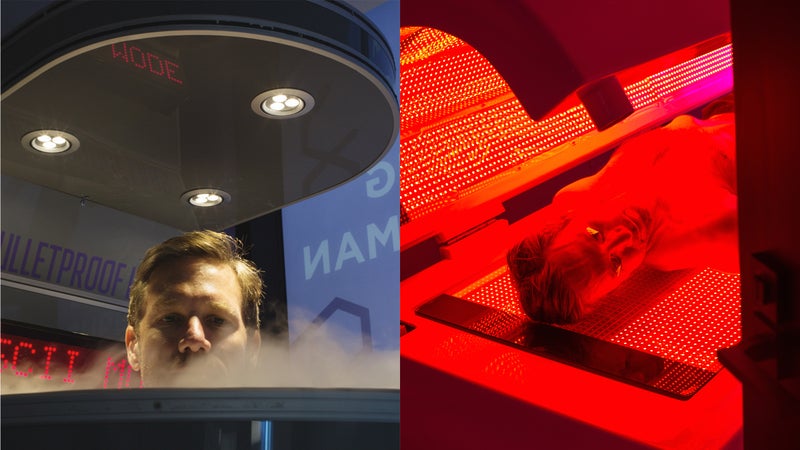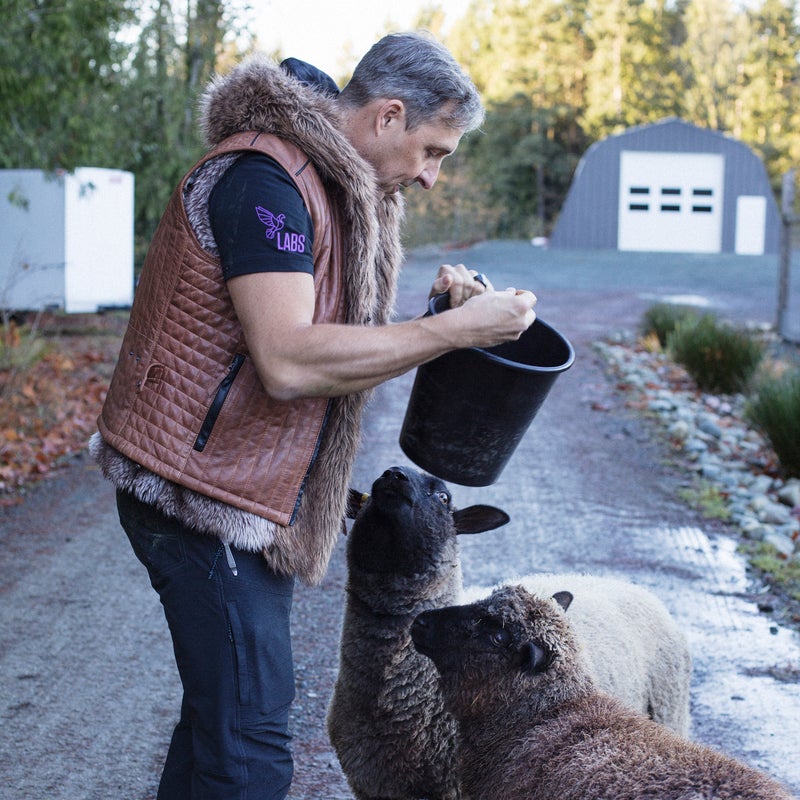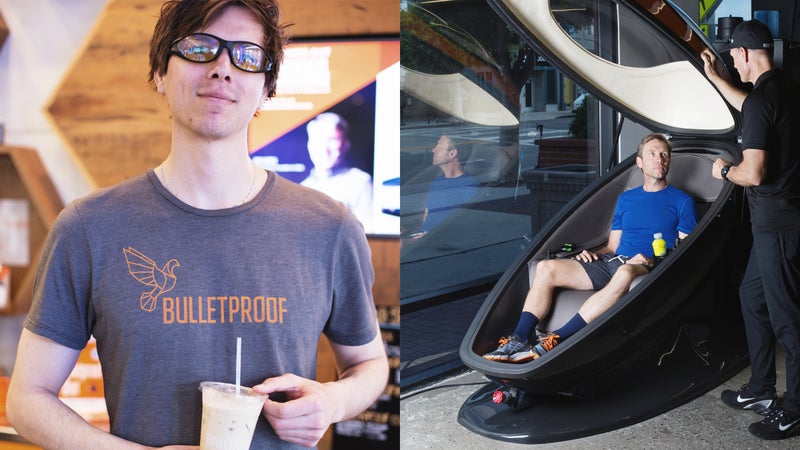Dave Asprey Wants to Make the Gym Bulletproof
The entrepreneur believes that biohacking can rocket your body and mind to peak performance. His Bulletproof diet zoomed into the mainstream, his Bullet-proof coffee has everyone quaffing butter, and his Bulletproof books fly off the shelves. Now Bulletproof Labs is out to hack, well, everything.
New perk: Easily find new routes and hidden gems, upcoming running events, and more near you. Your weekly Local Running Newsletter has everything you need to lace up! .
Bulletproof labs is located on a tony strip in Santa Monica, around the corner from Davy Jones Liquor Locker and a few blocks from Silicon Beach, the burgeoning tech hub occupied by Google, Snap Inc., and an untallied quantity of startups. The human-performance facility sits inside a low-rise brick building adjacent to Bulletproof coffee, best known for the fat-bomb java sensation launched in 2013 by biohacking impresario , author of the bestsellers Bulletproof Diet and Head Strong. The coffee is blended with grass-fed butter and triglyceride oil, and is purported to boost energy and mental focus while helping you lose weight. According to the company, more than 100 million cups of Bulletproof coffee have been consumed to date.
, which opened last October, is AspreyŌĆÖs next big thing, an attempt to expand his self-improvement empire beyond beverages and books. Modeled after Alpha LabsŌĆöAspreyŌĆÖs private million-dollar performance center at his home near Victoria, British ColumbiaŌĆöthe Santa Monica establishment will, Bulletproof claims, help you regenerate cells, shed fat, layer on muscle, calm your mind, recharge your soul, extend your life, and transform yourself into a productivity powerhouse.┬Ā
I arrive at the facility by bicycle on a warm fall day. Next door, Bulletproof CoffeeŌĆÖs outdoor tables are packed with young people hunched over laptops, cradling paper cups of buttery brain power. Bulletproof LabsŌĆÖ reflective glass windows give the place an air of mystery while reminding you that youŌĆÖre not as fit and optimized as you might like to think you are. For a middle-aged man whose body and brain are increasingly difficult to keep sharp, the promise of what awaits inside is tantalizing.
The space is bright and tight, a gleaming wellness arcade that includes, among other things, a cryotherapy tank, a bone-density trainer, and a recliner that emits electromagnetic pulses through your butt. ItŌĆÖs a gym of sorts (although Bulletproof insists that it isnŌĆÖt) but also a meditation center, recovery lounge, and body-analysis clinicŌĆöor, as I heard one person put it, a day spa for tech bros. Among the sophisticated machines are several large pods that resemble futuristic sarcophagi, one of which spins slowly, dreamily, behind a large glass divider. Depending on how youŌĆÖre feeling that day, you can have your naked body zapped with infrared lasers, receive intravenous vitamins, grunt out a high-┬Łintensity circuit on a recumbent trainer while wrapped in cold pads, or sit in a pressure chamber that will whisk you to the virtual summit of Everest and back to sea level in a few minutes.┬Ā

Access is obtained by purchasing $50 ŌĆ£bullets.ŌĆØ You cash these in for ŌĆ£hacks,ŌĆØ or sessions on the various machines. Customers can stack the hacks ├Ā la carte or pay for a package of sessions that includes a one-time baseline evaluation. The response has been overwhelmingŌĆöperhaps 1,200 sessions a monthŌĆösays CEO Martin Tobias, an investor and former tech executive from Seattle. During my visit, fit ŌĆ£biohacker techniciansŌĆØ wearing snug black T-shirts tend to a handful of clients of mixed gender and age. The plan is to roll out five more locations over the next two years, likely along the West Coast.┬Ā
Much of the technology has been in use for yearsŌĆöcryotherapy spas, for example, are popping up all overŌĆöbut the high price of equipment has kept it largely confined to pro sports, therapeutic institutions, and the private enclaves of wealthy health nuts. (The Atmospheric Cell Trainer, for exampleŌĆöwhich uses something called Cyclic Variations in Adaptive Conditioning, or CVAC, to simulate changes in altitudeŌĆöcan run up to $129,000.) ŌĆ£Dave wanted to take these products out of the billionaire class and make them accessible to the masses,ŌĆØ Tobias told me before my visit.
I meet my biohacker technician, Matt Reed, 58, who is lean and broad shouldered and looks like Ed Harris. This is mildly unsettling, since I recently binge-watched the HBO sci-fi series Westworld, in which Harris plays a menacing gunslinger, but Reed is the opposite of scary, and soon weŌĆÖre joking about achy bodies and foggy minds.
Bulletproof Labs will, it claims, help you regenerate cells, shed fat, layer on muscle, calm your mind, recharge your soul, extend your life, and transform yourself into a productivity powerhouse.
Hackers love numbers, and one thing that distinguishes Bulletproof is just how much data you can collect. ItŌĆÖs a Vegas buffet of self-quantification: body composition, basal metabolic rate, heart-rate variability, gut microbiome makeup, sleep quality, and other biometrics.┬Ā
Our first stop is a device called . It determines whether you are in ketosisŌĆöa metabolic state in which your body is burning fat for energyŌĆöby measuring the amount of acetone, a ketone body, in your breath. You blow into a small canister, place it into an analysis machine, wait a few seconds, and get your reading. A score of seven or higher is excellent: youŌĆÖre melting fat like candle wax. Three to six is OK: youŌĆÖre tapping some fat for fuel. One to two is no bueno, the dad-bod zone. I blow a point-three.┬Ā
Reed thinks the Levl isnŌĆÖt calibrated right. I think itŌĆÖs the steering-wheel-size blueberry pancake I had for breakfast. We try again, but my number doesnŌĆÖt change. He looks concerned.
ŌĆ£How low is that?ŌĆØ I ask.
ŌĆ£ItŌĆÖs low.ŌĆØ
ŌĆ£WhatŌĆÖs the lowest youŌĆÖve seen?ŌĆØ
ŌĆ£ThatŌĆÖs about it,ŌĆØ Reed says, then adds cheerily, ŌĆ£This is going to be easy!ŌĆØ
Biohacking has been around for a while. The term started cropping up in the Bay Area in the early aughts, often in reference to some kind of cyberaugmentation. It has roots in traditional hacker culture but applies to technology that modifies something organic, from altering cells in a petri dish to ultra-freaky ŌĆ£grinderŌĆØ body tweaks, like implanting speakers in your eardrums or embedding a vibrator near a manŌĆÖs pelvis (this exists and is called the Lovetron 9000), or, very recently, editing your own genes.┬Ā
Asprey has helped galvanize biohackingŌĆÖs middle ground, a kind of digital retooling of the self-help genre, and he has become its most recognizable, and at times controversial, pitchman. What began with nutritionŌĆöthe Bulletproof diet is high in fat, low in carbs, and consists mostly of whole foods consumed between periods of fastingŌĆöhas deepened and broadened. Asprey says that the key to health and longevity resides at the cellular level, in our mitochondria, the ŌĆ£tiny power plants that provide our energy,ŌĆØ and that we have the ability to control it.
ŌĆ£Aging is death by a thousand cuts, but it comes down to a few basic things that implement mitochondrial efficiency,ŌĆØ Asprey told me. ŌĆ£You get those things up and running, and you keep out the toxins that cause microdamage, which compounds over time. And then you turn on the bodyŌĆÖs natural repair systems, like with stem cells and cryo.ŌĆØ┬Ā

Similar to Tim Ferriss, author of The 4-Hour Work Week, Asprey has tapped into our growing obsession with shortcuts and self-optimization. His podcast, , is one of the most popular on iTunes. Since 2013, his annual biohacking , now held in Pasadena, has grown from a few hundred participants to nearly 3,000. Asprey has numerous businesses in addition to Bulletproof, like TrueDark, which sells red- and yellow-tinted glasses (├Ā la Bono and Ali G) intended to protect users from the worldŌĆÖs ŌĆ£junk light,ŌĆØ and 40 Years of Zen, a five-day neurofeedback-training program that he offers for $15,000 per person.
ŌĆ£When it comes to living better longer, tech is ahead of medicine right now,ŌĆØ Asprey says. ŌĆ£Medicine used to be tech, and in some ways itŌĆÖs catching up, but whoŌĆÖs going to go in to their doctor and say, ŌĆśI donŌĆÖt want to know if IŌĆÖm about to die from cancer. I want to know how I can get better from where IŌĆÖm at right now.ŌĆÖ ŌĆØ
Bulletproof Labs seeks to provide that service. The thinking is that the body is a system that can be understood and improved uponŌĆöhacked and upgraded, to use the lingoŌĆöby applying the right kind of stimulus in the right way. The equipment used is ŌĆ£science┬Āand evidence-based,ŌĆØ Bulletproof says, but this, as anyone who digs into the research will tell you, can be challenging to support. Peer-reviewed studies on whole-body cryotherapy, which is in wide use these days and embraced by celebrity athletes from LeBron James to Cristiano Ronaldo, have had mixed results. A few studies said it worked well for workout recovery; others reported it had no effect; and one stated that it performed worse than an ice bath or even a placebo.
A score of seven or higher is excellent: youŌĆÖre melting fat like candle wax. One to two is no bueno , the dad-bod zone. I blow a point-three.
Likewise, the CVAC pod, which Bulletproof claims offers ŌĆ£physical conditioning without stressing your body and joints,ŌĆØ attracted a lot of buzz in 2011 when Serbian tennis star Novak Djokovic credited it as a secret weapon during his breakout season. He later walked that statement back, and the device has since struggled to produce either endorsements or persuasive evidence that itŌĆÖs effective. The Research and Media tab on Bulletproof LabsŌĆÖ website offers three supporting links: two brochure-like documents from the CVAC corporation itself, and a 2010 study on pain relief in patients with a rare disease called adiposis dolorosa.
This kind of marketing might fall under what calls scienceploitation. Caulfield is the research director at the Health Law Institute in Alberta and the author of Is Gwyneth Paltrow Wrong About Everything? When Celebrity Culture and Science Clash. ŌĆ£Sometimes there is genuine research there,ŌĆØ he says, ŌĆ£but itŌĆÖs often taken to the extreme, dressed up with some science-y language, and claimed, This is efficacious.ŌĆØ
IŌĆÖd been experimenting with my own fitness long enough to understand that proof can be a big request. I swear by ice baths and massage, for example, even though thereŌĆÖs little scientific evidence that they make any difference in performance or recovery.
Before I headed to Santa Monica, I ran BulletproofŌĆÖs list of equipment by Craig Friedman, vice president of performance innovation at Exos, an elite training outfit based in Phoenix that I wrote about for ║┌┴Ž│į╣Ž═° last year. Friedman was bullish.
ŌĆ£The power of this technology gets unlocked by knowing what to do when,ŌĆØ he told me. ŌĆ£You need different types of recovery depending on what kind of training youŌĆÖre doing. ThatŌĆÖs where assessment and monitoring come in. The essence of biohacking is really getting in touch with how you feel.ŌĆØ
Reed sets me up for a session in BulletproofŌĆÖs signature Virtual Float Tank. The tank eliminates all outside stimuli, and you wear goggles that strobe white light and headphones that pipe in ambient music, meant to bring your mind into theta, a brain-wave frequency associated with deep relaxation and Zen meditation.┬Ā
He secures the pod lid, and the capsule starts spinning. I have a minute or two of claustrophobic panic, but then I relax and start to float upward through space. My body dissolves while Technicolor fractals bloom across my vision. I lose all sense of time passing. IŌĆÖm enveloped by the experience: color, music, the squishy syncopations of my own heartbeat. I succumb to a deep feeling of peace and contentment.
Afterward, I cycle through a few gizmos until we get to the Cold HIIT machine, designed by for high-intensity interval training. ItŌĆÖs basically a recumbent elliptical attached to a water cooler. The cooler pumps chilled water into compression cuffs wrapped around your thighs and upper arms while you perform a 21-minute circuit consisting of short bursts of effort followed by several minutes of recovery. The theory is that compressing and cooling blood during exercise increases testosterone production while reducing muscular damage. Hence BulletproofŌĆÖs claim that Cold HIIT delivers ŌĆ£two hoursŌĆÖ worth of exercise in 20 minutes.ŌĆØ ItŌĆÖs a good sell, and I can attest that the machine left me winded. But I kept thinking, as I glided through the hammer-and-recover circuits with my chilled arms and legs, that the machine has essentially re-created cross-country skiing.
IŌĆÖm standing near BulletproofŌĆÖs cryo chamber when a client, a man in his late thirties, passes out during his session. He tumbles out of the boothŌĆötorso frosted, face ashen, eyes rolling up into his head.
We proceed to cryo, which can be intimidating. You stand in an open-topped cylindrical chamber that surrounds your body in a fog of liquid nitrogen chilled to an arctic minus 240 degrees. The cold blast quickly shunts blood to your core, purportedly reducing inflammation and jolting your immune response. Mishaps are rareŌĆömostly mild frostbite. But in 2015, a 24-year-old employee at a cryotherapy spa in Las Vegas was found dead in a cryo chamber after prolonged unsupervised use. The coroner later ruled the cause of death ŌĆ£asphyxia in an oxygen-poor environment.ŌĆØ┬Ā
IŌĆÖm standing near BulletproofŌĆÖs cryo chamber when a client, a man in his late thirties, passes out during his session. Fortunately, Reed, who has been supervising, promptly opens the door and catches the guy as he tumbles out of the boothŌĆötorso frosted, face ashen, eyes rolling up into his head. A woman near us screams and runs into the bathroom crying. The client comes around after a minute or two and seems fine; heŌĆÖs a little fuzzy about what just happened but thinks he accidentally inhaled too much nitrogen vapor. I decide to take a pass on cryotherapy for the day.
When asked about the incident later, Bulletproof Labs CEO Tobias said heŌĆÖd heard about the episode. He understood that the man had been fasting and that the machine had not malfunctioned. The techs know how to deal with emergencies, he explained. ŌĆ£We have very advanced equipment here, and thatŌĆÖs why we have highly trained people like Matt who are with our members every step of the way.ŌĆØ It was true: despite my periodic pod anxiety, Reed was always on hand, watching closely.┬Ā
I spend a week at Bulletproof Labs working out and drinking hot buttered coffee, then catch a plane to Vancouver Island to meet the biohacking wizard himself. Asprey, 44, lives on a lush 32-acre spread north of Victoria with his wife, Lana, a physician and fertility coach, and their two kids, Alan, eight, and Anna, ten. There is a large vegetable garden that has recently been harvested, and a few pet sheep are foraging around the beds. Next to the garden is a renovated barn with a green pitched roof and a sign above the door reading Bulletproof Labs Alpha.
Asprey appears in the driveway. HeŌĆÖs wearing gray hiking pants and a black T-shirt with UPGRADED printed across the chest. He is a large, good-looking guy, though not as large as he used to be.┬Ā
As a kid growing up in Albuquerque, New MexicoŌĆöhis parents were scientists at Sandia National LaboratoryŌĆöAsprey suffered strange rashes and persistent nosebleeds, problems he would later attribute to mold poisoning. He also struggled with low energy, a kind of never-ending chronic fatigue syndrome, and by the time he was out of college he weighed 300 pounds. He propped himself up on an ever intensifying regimen of stimulants and nootropics, or smart drugs: large doses of caffeine at first, as well as piracetam, a cognitive enhancer that has been used abroad to improve memory but is not approved by the FDA for medical use. Asprey has also used modafinil, another nootropic, as well as small hits of nicotine extract, although heŌĆÖs vehemently anti-smoking.
Despite his early health issues, Asprey built a successful career in tech, helping develop cloud computing and, he claims, pioneering e-tail. (He marketed a T-shirt that read Caffeine is My Drug of Choice through an online news group in 1993.) But by his mid-twenties, his health was out of control. He dislocated his patella and tore his meniscus playing goalie in a soccer game; then, after surgery, injured the knee twice more. The injuries were a turning point, he says. ŌĆ£I was still fat, still inflamed, and IŌĆÖm sitting there like, What I am doingŌĆöthe exercise and dietŌĆöjust doesnŌĆÖt work.ŌĆØ

After his second surgery, Asprey dropped 50 pounds on a low-fat, low-calorie diet. But with his health still poor, he kept searching, a quest that ultimately led him to the Silicon Valley Health Institute, in Palo Alto, a group that attracts mostly older tech executives interested in longevity. The group was focused on methods to improve mind and bodyŌĆöyoga, meditation, neurofeedback, and the like.
ŌĆ£I learned so much from these people, who are two and three times my age, because I had to deal with the same diseases of agingŌĆöarthritis, prediabetes, cognitive issuesŌĆöwhen I was young,ŌĆØ Asprey says. ŌĆ£What I found was that no one cares about antiaging until theyŌĆÖre old, so I started exploring.
ŌĆ£What people are looking for is control over the system,ŌĆØ he continues. ŌĆ£You might want to get swole, you might want to live forever, you might want your brain to work all the time, or you might want to be hyper-fertile. You want your artistic spark to turn on. Maybe you just want to have a ton of energy when you come home so you can play with your kids. It all comes down to one thing: How do I make this system do what I want it to do?ŌĆØ
By 2010, when he started the Bulletproof blog, heŌĆÖd caffeinated and smart-drugged his way through Wharton Business School, trekked around Tibet and discovered the yak-butter tea that would inspire Bulletproof coffee, and settled on Vancouver ┬ŁIsland with his family. Asprey was earning six figures as a tech consultant but knew he was onto something bigger. He started selling the coffee in 2011 to readers of his blog. He was getting early feedback that it really worked and that people loved it, and the market hadnŌĆÖt even been created yet. Asprey was able to raise $8 million in his first round of investment.┬Ā
Asprey shows me around Alpha Labs. HereŌĆÖs the new two-person Virtual Float Tank, thereŌĆÖs the cryo booth, the CVAC, the infrared sauna, the Ping-Pong table. Upstairs is the kitchen for developing Bulletproof recipes, the podcast bay with hexagonal sound-dampening ceiling panels, a custom bookcase modeled on a Fibonacci spiral. ItŌĆÖs the ultimate wellness man cave, styled with a steampunk Burning Man motif. (HeŌĆÖs a regular attendee of the desert bacchanal.)┬Ā

Asprey doesnŌĆÖt try to pose as a scientist, but he wants the science he uses to be taken seriously. When , his 2017 book about improved cognitive performance, made The New York Times bestseller list, he felt particularly vindicated.
ŌĆ£It hit the science list, not the advice list,ŌĆØ Asprey says. ŌĆ£IŌĆÖm like, Did that just happen? That was a peak moment in my career. It takes thousands of hours to write a book like that. There is so much synthesis going on.ŌĆØ
There is also abundant controversy surrounding BulletproofŌĆÖs claims. Some doctors have presented evidence, including a case study shared at a meeting of the American Association of Clinical Endocrinologists in 2014, suggesting a correlation between otherwise-healthy individuals incorporating Bulletproof coffee into their diet and elevated blood lipidsŌĆöa cardiac risk factor. Running coach Steve Magness called the Bulletproof Diet bogus on his Science of Running blog in 2014, arguing that whatever benefits Asprey claims heŌĆÖs experienced from his coffee and nutrition plan come from his use of testosterone, nootropics, and thyroid medication. ŌĆ£He portrays himself as a ŌĆśbiohackerŌĆÖ who has found out all of these secrets about diet, exercise, and such,ŌĆØ Magness wrote, ŌĆ£when the reality is heŌĆÖs simply a guy who took and continues to take PEDs.ŌĆØ For his part, Asprey has always been transparent about his drug use.┬Ā
He came under additional fire for insisting that Bulletproof coffee is processed to eliminate mycotoxins (toxic mold), and got a huge bump in sales when he touted this on the Joe Rogan podcast in 2014. Rogan later fact-checked the claims, and in a subsequent episode roasted Asprey for saying Bulletproof was toxin-free while other coffees were not, which isnŌĆÖt true: the coffee industry safeguards against mold toxicity, which has only been found in minuscule amounts. Asprey has since toned down the claims but hasnŌĆÖt recanted them. ŌĆ£Mycotoxins are real,ŌĆØ he told me.
Science dogs him, but he argues that data gets manipulated in all kinds of ways. ŌĆ£This is how Internet discourse happens in health,ŌĆØ says Asprey. ŌĆ£We can all play HereŌĆÖs the Latest Studies, I Just Found the Latest Random Stuff. But when you look at a thousand studies, and then you try it out, and then you understand some metabolic pathways, and you hypothesize, and then you test, and you look at the results, the name for that is science. And every new scientific discovery is completely crazyŌĆöuntil itŌĆÖs not.ŌĆØ
Because studies┬Ācan take a long time, and often cost a lot of money, biohackers like to use themselves as lab rats. This tactic employs only a single subjectŌĆöan n of oneŌĆömeasured over time. A common approach goes something like: gather some data, start your intervention, measure again, and repeat until you are satisfied that something is working or isnŌĆÖt.
AspreyŌĆÖs own n of one makes Bulletproof Labs look conservative. He is one of only two people in the world, he says, to have had their stem cells harvested and injected into their brains to help preserve cognitive function. He will tell you, without irony or sarcasm, that he plans to live to 180. He claims to have hacked his wifeŌĆÖs infertility using a low-carb prototype of the Bulletproof Diet, which they wrote about in The Better Baby Book, published in 2013. Once, in an attempt to learn Swedish, he zapped his head with infrared light to the point where his speech remained garbled for hours. ŌĆ£Scared the shit out of myself,ŌĆØ he says.
ŌĆ£You might want to get swole, you might want to live forever, you might want your brain to work all the time,ŌĆØ Asprey says. ŌĆ£It all comes down to: How do I make this system do what I want it to do?ŌĆØ
His PR stunts have also been colorful. Asprey was ridiculed for appearing in a YouTube video in which he eats an entire stick of butter. And he has taken additional, though diminished, heat for developing a recipe for a supposedly hormone-boosting coconut-milk ice cream, which he calls Get Some, that purportedly renders you sexually irresistible. ŌĆ£About an hour after eating this special blend of high-fat awesomeness,ŌĆØ he writes on the Bulletproof blog, ŌĆ£your body gets a signal that says, ŌĆśI am in a land of plenty,ŌĆÖ which translates, in evolution-speak, to, ŌĆśIt is time to mate. Now.ŌĆÖ ŌĆØ
At Alpha Labs, I mention how being enclosed in the pods made me anxious.┬Ā
ŌĆ£One of the things that weŌĆÖre most wired for is control,ŌĆØ Asprey says. ŌĆ£If IŌĆÖm not in control, I might die. So our nervous system, automatically, is like, IŌĆÖm suspicious of something new, might be dangerous. And it slows down our progress. It drives resistance and avoidance to new things.ŌĆØ
ŌĆ£But for good reason, right?ŌĆØ I offer. ŌĆ£Like self-preservation.ŌĆØ
ŌĆ£That might have been true 100 years ago, if you wanted to eat a new plant,ŌĆØ Asprey says. ŌĆ£With the stuff at Labs, the benefit is well worth the risk, because the risk isnŌĆÖt very high. And the benefit is much better than whatever we were doing before.ŌĆØ┬Ā
ItŌĆÖs getting on toward late afternoon, and Asprey makes himself an espresso. Anna is home from school and joins us, clambering into the loft above the podcast studio.┬Ā
ŌĆ£Biohackers are the people who are going to push the limits and show whatŌĆÖs possible, and then science is going to follow,ŌĆØ Asprey says. ŌĆ£ThereŌĆÖs a huge question of medical freedom. LetŌĆÖs say you want to experiment with microdosing, which is happening everywhereŌĆöyou have to go 200 miles offshore.ŌĆØ
ŌĆ£WhatŌĆÖs microdosing?ŌĆØ his daughter queries from the loft.
ŌĆ£IŌĆÖll tell you later,ŌĆØ Asprey shoots back.
ŌĆ£I have a moral obligation to be careful about what I share,ŌĆØ he continues. ŌĆ£There are a lot of people who would just blindly do what IŌĆÖm doing, but IŌĆÖm a six-foot-four male, I have a history of autoimmune disease, I was obese for most of my life. If youŌĆÖre a 90-pound woman, youŌĆÖre not going to like what happens.ŌĆØ
He pauses. Lana has appeared at the top of the stairs. ThereŌĆÖs a problem with Rosie, one of the sheep; she has eaten something in the garden, and bloody sputum is foaming out of her mouth.
ŌĆ£We need to put baking soda and water down her throat. She could die,ŌĆØ Lana says.┬Ā
There is some hurried discussion about the location of the syringes and supplies, and then Lana disappears.┬Ā
Luckily, Rosie ends up recovering, but Asprey hardly skips a beat.ŌĆ£We can argue about ethics all night,ŌĆØ he says. I get the sense that itŌĆÖs not the first time heŌĆÖs made this point. ŌĆ£A hundred thousand years ago, there were two cavemen. One of them said, ŌĆśI found this fire, and IŌĆÖm gonna use it to keep my cave warm this winter,ŌĆÖ and the other said, ŌĆśThatŌĆÖs cheating.ŌĆÖ One of those two cavemen is our ancestor.ŌĆØ
By the time my week at Bulletproof Labs in Santa Monica was over, not only was I not feeling good, IŌĆÖd been stricken by a strange malaise. On my last day, in lieu of a workout, Reed had me chill out in a leather recliner, breathing something called EZ Water, piped under my nose by a small humidifier. The good news was that my Levl score that morning had climbed to 1.3.
I chatted with another client, Andrew, a Toronto real estate agent who was unabashedly stoked on Bulletproof. His story was familiar: young guy buries himself in his career, winds up in terrible shape, cashes out, and starts looking for a health intervention.
ŌĆ£I found my way to Bulletproof, and it was this mic-drop moment,ŌĆØ he told me. ŌĆ£At home IŌĆÖm like this freak of nature, but here IŌĆÖm surrounded by people who know more about biohacking than I do. As humans, we need our tribe, you know?ŌĆØ
I kept thinking about how our species has long been more easily persuaded by a good story than hard evidence, that opting in has been more evolutionarily advantageous than opting out. I wanted to opt in to Bulletproof. The self-assessment made sense, and I liked some of the machines, like the Virtual Float Tank. But there was very little movement, and zero contact with nature. For my own n of one, I needed something else.┬Ā
Late that afternoon, I rode my bike down to the beach and shuffled across the sand near the Santa Monica Pier. It struck me that a lot of what passed for health and fitness now was just an attempt to synthesize what humans have done for eons: move around outside, sometimes intensely; eat food from the earth; sleep a lot; hold on to each other. Were we just trying to hack our way back to nature? If technology had gotten us into this mess, was it going to bail us out?
I sat down and buried my feet in the cool, damp granules. A dozen or so surfers bobbed in the water, silhouetted by the setting sun, the waves curling into mist. It was one of those SoCal evenings you want to last forever. Behind me, Los Angeles thrummed, long veins of traffic clotting up the metropolis. I flopped on my back and waved my legs and arms up and down to make an angel imprint. The sand felt great. It felt like medicine.┬Ā
Contributing editor Nick Heil () is ░┐│▄│┘▓§Š▒╗Õ▒ŌĆÖs former Lab Rat columnist. He wrote about Exos Fitness in October 2016. Contributing Photographer ╠²▒Ķ│¾┤Ū│┘┤Ū▓Ą░∙▓╣▒Ķ│¾▒╗Õ Sally Bergesen┬Āin June 2016.┬Ā


